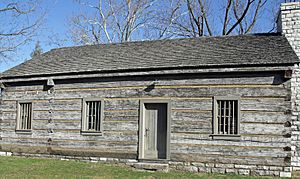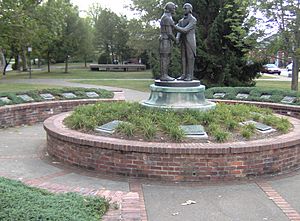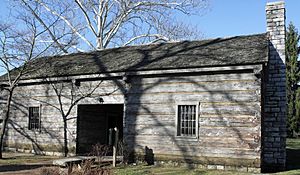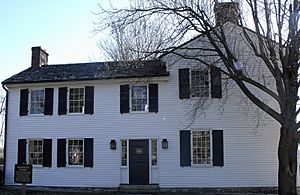Constitution Square Historic Site facts for kids
Quick facts for kids Constitution Square Historic Site |
|
|---|---|
 |
|
| Type | County park |
| Location | Danville, Kentucky |
| Area | 3 acres (1.2 ha) |
| Created | 1937 |
| Operated by | Boyle County Fiscal Court |
| Open | Year-round |
Constitution Square Historic Site is a special park and open-air museum in Danville, Kentucky. It covers about 3-acre (0.012 km2) of land. For many years, from 1937 to 2012, it was part of Kentucky's state park system. Now, the local government of Boyle County, Kentucky takes care of it.
This park celebrates Kentucky's early political history. It has copies of three important buildings that once stood here. One is the courthouse where ten big meetings happened between 1785 and 1792. These meetings helped Kentucky become its own state, separate from Virginia. The park also has the real building that was the first U.S. post office west of the Allegheny Mountains. You can also see other old buildings from the early 1800s.
Constitution Square is a big part of the Constitution Square Historic District. This area was added to the National Register of Historic Places in 1976. Many fun events happen here each year. These include the Great American Brass Band Festival and the Soul of Second Street, which celebrates the history of African-Americans in the area. The Kentucky State Barbecue Festival was also held here for a few years.
Contents
Exploring the History of Constitution Square
In 1774, brave pioneers like James Harrod built Fort Harrod. This was Kentucky's first lasting settlement. Soon after, three settlers claimed land where Danville, Kentucky is today. In 1784, one of them, John Crow, gave 76 acres (0.31 km2) to Walker Daniel. This land became the city of Danville.
The city square was placed on the eastern side of this land. It was not in the middle, which was unusual. This spot was about 500 feet (150 m) from John Crow's Station. It offered a safe escape if there was an attack from Native Americans.
Kentucky's Path to Statehood
In 1783, the Virginia General Assembly created the Judicial District of Kentucky. Harrodsburg was the first place for the district's court. But its buildings were not good enough. So, the Supreme Court for the District of Kentucky moved to Crow's Station. They ordered a new courthouse to be built there.
This courthouse was built on what is now Constitution Square in March 1785. The court met there regularly until Kentucky became a state in 1792. After Kentucky became a state, the square was not used as much.
Changes to the Square Over Time
In 1817, the city leaders sold half of the square. They wanted to raise money for a school called Danville Academy. They planned to buy at least 1 acre (0.0040 km2) of land for the school. In 1818, they voted to sell the other half for the same reason.
It seems Danville Academy was never built. Instead, the money likely went to help start Centre College in Danville. This college is still a big part of the community today.
The city leaders also let a group of Freemasons use the courthouse for free in 1817. Later, in 1823, they sold another part of the square for homes. The Freemasons bought the courthouse and its land in 1828. A group of Methodists bought the land in 1834. They then sold it to a Reverend Adams. He started an all-girls school, but it did not last.
In 1854, the Danville Theological Seminary moved to Constitution Square. They used many of the buildings. The brick courthouse became the main building for the seminary. During the Civil War, it was used as a hospital. Wounded soldiers from both sides were treated there. The seminary closed in 1878. The main building eventually fell apart and was taken down.
Creating Constitution Square Park
On October 15, 1937, Emma Weisiger gave the land for Constitution Square to Kentucky. She did this to honor her brother, John. The state turned the land into a state park. It was first called Old Public Square, then Constitutional Square.
Local groups helped build copies of the jail, courthouse, and meetinghouse. These were like the original buildings on the square. The park was officially opened on April 20, 1942. It was named the John G. Weisiger Memorial State Park. Later, its name changed to Constitution Square State Shrine.
During World War II, many building projects stopped. But speeches at the park's opening reminded everyone about the war. They also praised the ideas of democracy. A special plaque was also put up. It honored the people who wrote Kentucky's first Kentucky Constitution.
After the war ended in 1945, building projects started again. In 1948, the state began fixing up Constitution Square. They restored buildings, added furniture, and built walkways. They also put up signs and improved the landscaping. These improvements were finished in 1955.
From 1960 to 1968, more changes happened. A fence was added around the site. New lights and displays were put in. A copy of the original pillory was built. Several buildings were also updated. This included an old brick schoolhouse that became the park caretaker's home.
In the 1970s, Centre College president Thomas A. Spragens helped improve Danville. He used money from the U.S. Department of Housing and Urban Development. One project was making Constitution Square bigger and restoring its important parts. Part of First Street was closed for this expansion.
The Governor's Circle was added to the site. It has a bronze statue of two men shaking hands. This is a symbol from the state seal. Plaques around the statue honor each governor of Kentucky. The Governor's Circle honors Isaac Shelby, Kentucky's first governor. He is believed to have chosen Kentucky's motto: "United we stand, divided we fall". The Garden Club of Danville takes care of the plants around the circle.
Modern Updates and Community Involvement
In June 2011, Kentucky's Department of Parks talked about giving Constitution Square to Boyle County. The change happened on March 6, 2012. The county received a $500,000 grant to improve the site. This aimed to make Constitution Square an important place for the local economy.
Improvements included making the first floors of all buildings accessible for people with disabilities. Electrical and phone systems were updated. A wireless network was installed to make the whole site a Wi-Fi hotspot. An archeological study was needed before work could start. This study was delayed because of a big debate at nearby Centre College in October 2012.
In February 2013, the Kentucky Historical Society put up a historical marker in the park. It honors the African-Americans who joined the Union Army during the Civil War. In May 1864, 250 men, many of them formerly enslaved, marched from Danville to Camp Nelson. They were the first to join the army at this site. About 10,000 United States Colored Troops trained there.
On September 10, 2013, Boyle County leaders voted to set aside $100,000. This money helps maintain the park. The county gets 4% of this money each year to spend on park upkeep.
Historic Buildings at Constitution Square
Constitution Square is located between Main Street and Walnut Street. It is also between First Street and Second Street. The park has one original building, the post office. It also has copies of the original courthouse, jail, and meetinghouse. These copies were built to look as real as possible, based on old records.
The First Post Office West of the Alleghenies
The post office at the north end of Constitution Square is an original building. It was built before 1792. It was the first U.S. post office west of the Allegheny Mountains. Thomas Barbee was its first postmaster, starting on August 20, 1792. The first mail arrived on November 3, 1792.
The post office was first on Walnut Street. In 1950, it was moved to its current spot by the Danville and Boyle County Historical Society. It was given to Kentucky on August 20, 1951.
Courthouse and Jail: Where Kentucky Began
The District of Kentucky and its Supreme Court were created in 1783. When the court moved to Danville in 1785, it needed buildings. Two men were chosen to figure out the cost of a courthouse and jail. Isaac Hite was chosen to build them, and they were finished in 1785. The jail was in the center of the square. The courthouse was between the jail and Walnut Street.
The district court met in Hite's courthouse starting March 14, 1785. They continued meeting there until 1792. The Kentucky Council of War also met in the courthouse. Between 1785 and 1792, ten important meetings, called constitutional conventions, happened there. These meetings created Kentucky's first Constitution, adopted in 1792. The original courthouse was later replaced with a two-story brick one.
We don't know much about the original jail. Records show it was made of thick logs and had at least two cells. The copy of the courthouse in Constitution Square was finished in 1942. It holds items belonging to Kentucky's first governor, Isaac Shelby. These include his hunting bag, powder flask, and the chair where he died. The courthouse also has a picture of Shelby and some Native American artifacts.
The Presbyterian Meetinghouse
People believe John Crow built a meetinghouse on the square before 1784. But the first one in records was built in mid-1784. It was for Presbyterian minister David Rice. A copy of this meetinghouse was built in Constitution Square in 1942. It is a one-story log building with a small bell tower.
Rice's original meetinghouse was used by the first Presbyterian church in Kentucky. The first two Presbyterian ministers in Kentucky were ordained there on November 10, 1785.
Grayson's Tavern: A Place for Big Ideas
Benjamin Grayson built Grayson's Tavern in Danville around 1785. It is an L-shaped building facing Walnut Street. It has an entrance on the front and one on the side. Behind the tavern is the Mary Akin Memorial Herb Garden. It has many herbs grown in the late 1700s and early 1800s. The Garden Club of Danville takes care of it.
The Danville Political Club often met at the tavern. This club was a group that debated ideas from 1786 to 1790. Many members became important leaders in Kentucky and the U.S. Eleven members took part in the meetings that helped Kentucky become a state.
Some famous members included James Brown, Kentucky's first Secretary of State. Also, Christopher Greenup, Kentucky's third governor. And Thomas Todd, a justice of the Supreme Court of the United States. The club's history was almost lost. But a grandson of the club's secretary found detailed notes. He later published them.
In 1787, Benjamin Grayson sold the tavern. It became a private home. The copy of Grayson's Tavern in Constitution Square now holds offices. These include the Convention and Tourism Bureau and The Great American Brass Band Festival.
The Schoolhouse and Other Buildings
We don't know much about the brick schoolhouse. It faces Constitution Square. People believe it was built around the same time as nearby buildings. It may have been a private school. The Danville-Boyle County Convention and Visitors Bureau says it was built around 1820. They say it was the first brick schoolhouse west of the Allegheny Mountains.
This one-story building has two rooms. It has a stone foundation and brick walls. When Constitution Square was a state park, the park manager lived here. Now, it is a conference center with meeting space.
Jeremiah Fisher built two row houses in 1817. They share a wall and are made of brick. These houses are on Second Street and face Constitution Square. Fisher owned and rented them until 1850. Later, they were used as apartments. Today, they house the Danville-Boyle County Chamber of Commerce and other local groups.
The Watts–Bell House was built in 1816. It was for a merchant named David Bell. Bell's son, Joshua Fry Bell, who became a legislator, grew up here. This two-story house is between Fisher's Row Houses and Grayson's Tavern. It also faces Constitution Square. It now has offices and a conference room for local economic development.
The Alban Goldsmith House was built before 1820. It is a brick house with chimneys on each end. It faces Second Street, across from the Ephraim McDowell House. Dr. Alban Goldsmith owned this house. He studied medicine with Ephraim McDowell. Goldsmith helped McDowell with the first ovariotomy surgery. He also helped start the Louisville Medical Institute.
The Alban Goldsmith House now has the Constitution Square Museum Store. It also houses the Heart of Danville, a group that helps the local economy.
Fun Events at Constitution Square
In April 1987, the local newspaper, the Danville Advocate-Messenger, started the first Rally on the Square. This is a political event where candidates for state office give speeches. They also meet voters. Since then, the rally happens every four years in April.
The first rally had a brass band from Centre College. This inspired the city to start the first Great American Brass Band Festival in 1990. This festival has been held every June since then. Constitution Square is one of the places where outdoor performances happen during the festival.
The first Constitution Square Festival was held in 1979. It happened every year in September. It featured historical reenactments, crafts, food, and music. In 2009, the state stopped funding the festival. But local groups volunteered to keep it going. They focused more on arts and renamed it the Constitution Square Arts Festival. This event continued until 2011 but was paused in 2012.
Constitution Square has hosted a charity run every year since 1978. After Danville's Community Arts Center opened in 2004, a local businessman renamed it the Constitution Square 5K Run for the Arts. He organized it to raise money for the center. A local artist creates special awards for the winners.
In November 2011, the first Kentucky State Barbecue Festival was held in Constitution Square. It was very popular. The next year, the festival moved to September. The Southeast Tourism Society named it one of its Top 20 Events in the Southeast for September 2013.





